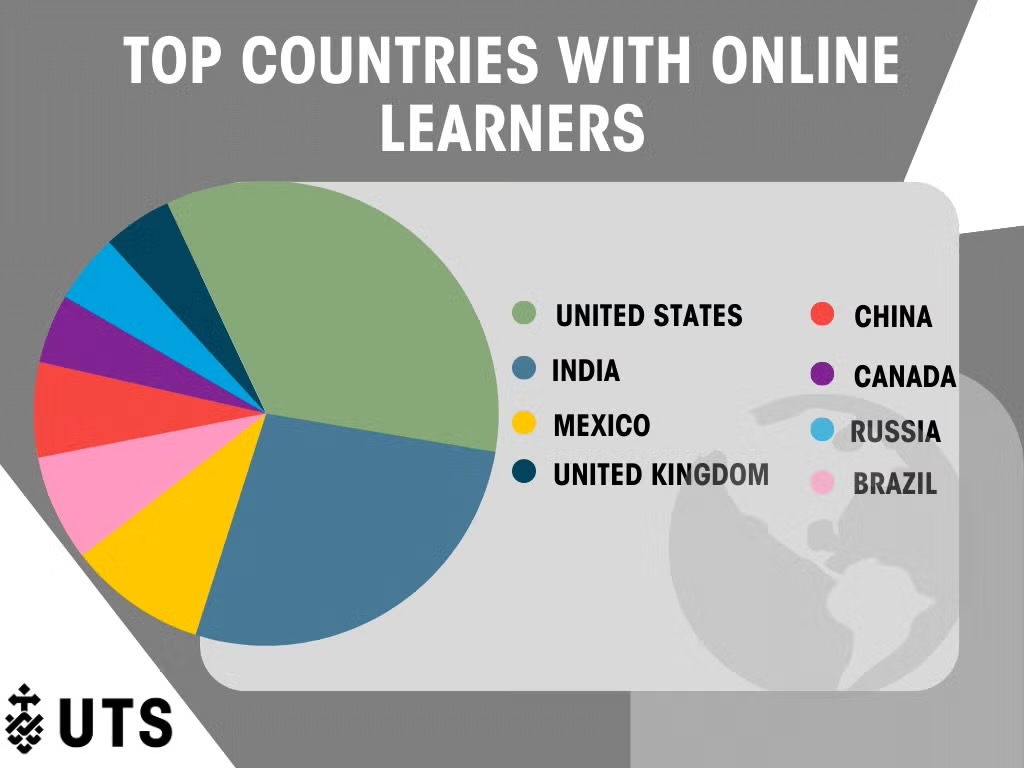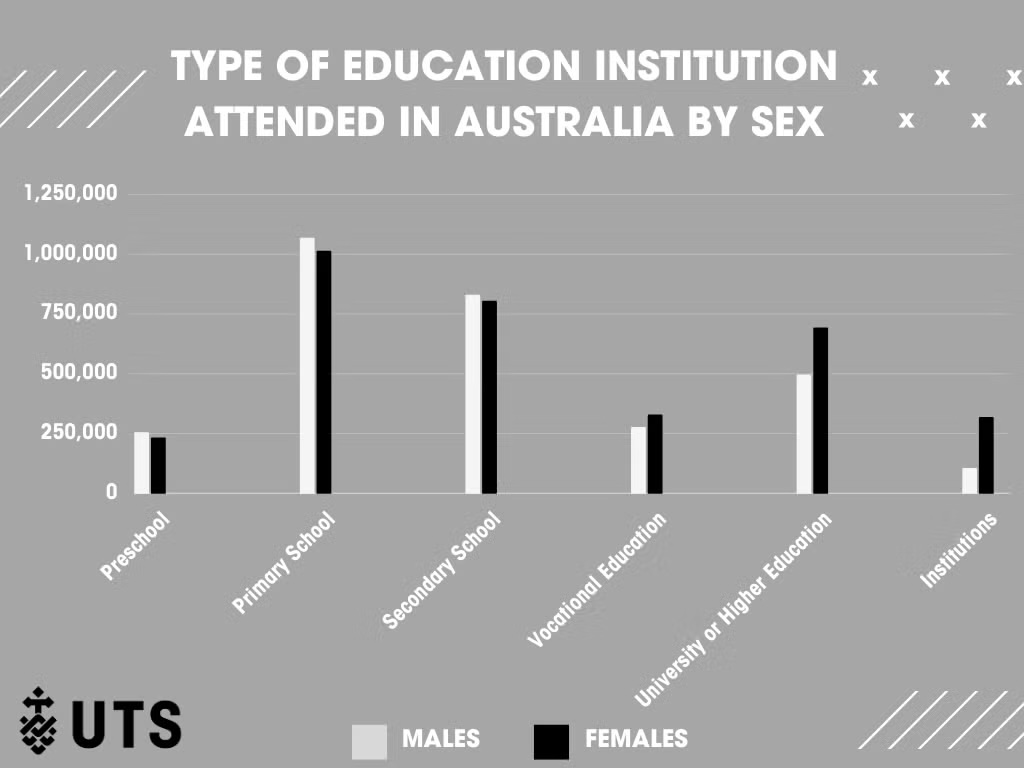Global education statistics 2023


The education sector has experienced significant changes over the past few years, with all levels of education being greatly affected by the Covid-19 pandemic and the increasing integration of technology. These events have created widespread changes throughout the globe, especially in how education is presented and what tools students use to learn, amongst other aspects.
Our data will comprise all global areas of education, from primary school-age children to those who have just completed tertiary schooling, such as a Master of Education, for an accurate picture of current standards and practices of education.
1. Overview of education statistics around the world
When looking at key education statistics, it is best to initially take a global approach to comprehend how educational attainment has progressed within the last few years. Despite education being a basic human right, many areas lack quality education or educational facilities. Factors like this need to be accurately logged and analysed to understand how economic, societal, and political aspects of life intersect with education.
A close-up analysis of countries like the United States, the United Kingdom, and Australia can provide general oversight of how education is evolving or remaining the same. These countries are some of the highest achieving countries when it comes to education and have also been greatly affected by the past few years of education reform and new technologies, making them excellent choices for an in-depth analysis.

United States
The United States is regularly ranked as one of the best-surveyed education systems globally, despite students across all levels of education consistently scoring lower in core subjects like maths and science than in many other countries. It is theorised that this fall in global positioning is due to a lack of investment by the government in the education sector, especially when factoring in the prominence of inflation in recent years.
- In terms of educational attainment, secondary education was recorded in 2022 as the highest level of school completed in the U.S. at 28% of the population, with the lowest being a high school diploma at 9%. The percentage of U.S. residents who have attained a bachelor’s degree has not changed significantly since 2020.
- 50% of public K-12 schools hire staff with specialist assignments in teaching.
- 39% of women aged 25 and older have completed a bachelor’s degree or more as their highest educational attainment, followed by 26.2% of men.
- 98% of classrooms have internet access, with 90% of all K-12 schools offering at least one computer for every five students.
- Recent immigrants are more likely to have attained a college education than earlier immigrants or even U.S. natives.
- The American EdTech market is expected to reach USD $605.40 billion by 2027.
- Most U.S. teachers (73%) have reported that the increased access to individual computers for students makes the teaching and learning process easier.
- 96% of teachers also believe the inclusion of technology in lessons positively impacts student participation.
United Kingdom
The United Kingdom is another region known to consistently rank well in quality education, with 99% of residents aged 15 and above being literate. This can be attributed to the fact that public education is mandatory for all residents in the UK, beginning with primary education and ending with secondary education.
- A significant portion of UK teachers across educational levels are female, with 74% of the 2021/22 workforce being recorded to identify as such.
- Most tertiary students attend state-funded schools or colleges, with 1,175,615 enrolled members, compared to privately funded schools at 114,370.
- 73.2% of secondary school-age residents reached a GCSE pass rate in 2022, while the 20% of students achieving a higher pass grade in 2017 increased to 26.3%. Female students have consistently had a higher pass rate than boys since the introduction of GCSEs in the 1980s.
- Within the past national school year, around 679,970 international students studied in the UK. While there has been an increase of international students enrolled in undergraduate programs since 2019/20 (2.4%), this number has been a decrease from 2020-21 by 2.3%.
- The amount of tertiary education graduates has significantly increased in recent years, with 57% of 25-34-year-old residents having a degree, compared to 29% in 2000.
- The amount of postgraduates and undergraduates enrolled in tertiary education has consistently increased in the past few years, even with the interruption of the pandemic. Female students have also been consistently participating more in tertiary education than boys in recent years.
Australia
With over 3.95 million students enrolled in public and private schools across the country as of 2021, it is obvious that the education sector is greatly appreciated in Australia.
Australians are among the highest-performing students in global education rankings, from primary school-age children to those pursuing higher education. Although there may have been some changes to education procedures due to the need for online education during the Covid-19 pandemic, this consistency has generally remained intact.
- The average student-to-teacher ratio in Australian schools sat at 13.1 last year, and this ratio may continue to stay low as the annual growth rate for school enrolments was only 0.3%, the lowest growth rate in recent years.
- 20% more international students enrolled via visa in January 2023 than compared to the previous year. The majority of these students came from China (23%), followed by India (16%) and Nepal (10%).
- There has been a 19.8% increase in Australians having a non-school (vocational or tertiary) qualification since 2016.
- The most common field of study in post-primary education has been Business and Management, followed by Education courses, then Nursing. However, the fastest growing is Security Science, followed by Artificial Intelligence and Southern Asian Languages. This indicates a growing focus on global studies and technology needed in the professional market.
- In the 25-35 age group, 90% have completed their secondary school studies, an increase from 88.2% in 2019. From this age group, 63% have also completed tertiary-level qualifications.
- From March 2021-22, 42% of Australians in the 15-74 age group had participated in some form of professional learning. This was equivalent to 7.8 million of the populace.
- During 2021-22, when the pandemic was at its peak, online learning was the most common way Australians received work-related training at 55%. This is a significant rise from 19% in 2016-17.
2. Global literacy rates
Literacy is a fundamental skill introduced from the beginning of any educational system. Globally, the skill someone holds in literacy often determines the success of their career path and the number and degree of opportunities they can take advantage of.
Global literacy rates can often be difficult to compare from country to country as not all countries report their literacy capabilities each year and may have different definitions of ‘literacy'. Regardless of these difficulties, it is vital to understand and analyse how the education system in each country is striving to meet the Sustainable Development Goal of all youth and most adults being literate by 2030.
- The literacy rate for those 15 years of age and above is 86.3%; males have a literacy rate of 90%, while women only have 82.7%.
- Developed countries are regularly found to have a high adult literacy rate of 96% and above.
- Despite many developing countries still finding it difficult to raise female literacy rates, the overall global percentage of literate females aged 15 years and above has steadily risen for decades. With only 59% of the world’s population of women over 15 years of age being literate in 1976, 82.7% shows that the gender literacy gap is shrinking yearly.
3. Enrolment rates
Across the world, the education sector is encouraged to focus on the continued enrolment of students throughout all levels of education. Not only does pre-primary, primary, and even tertiary education impart integral skills like literacy, numeracy, language, and socialisation, but it also secures children's futures. Ensuring that children enrolled in primary education continue their studies into secondary school and above can help secure the future of our global youth.
- Pre-primary school enrolment worldwide has grown exponentially since a recorded 16% in 1970. The necessity for pre-primary education has become apparent over the years for developing essential numeracy, literacy and social skills, hence the rise to a 61% gross in 2020.
- 90% of females enrolled in primary education completed their studies in 2020, a 20% improvement from 1975.
- 91% of primary school-age males in 2020 completed their primary school studies once enrolled, an improvement of 79% recorded in 1972.
- Overall, 90% of the world’s primary school-age population completed their primary education in 2020 after a few years wavering between 88-89% from 2008.
- The global percentage of females progressing to secondary school has been fairly steady in the past two decades, hitting an all-time high of 92% in 2011 and remaining around 90-91% until 2020.
- The percentage of males worldwide that have progressed to secondary school enrolment has followed a similar pattern to females. Rates sat at 91% in 2020 and followed near-identical rises and falls over the past few decades.
- The gross percentage of children enrolled into secondary school has exponentially increased since the 41% in 1970. Recent studies in 2020 showed that 77% of primary school-age children are enrolling into the next level of education.
- The tertiary education system has shown continuous improvements in enrolment rates. Previously being a privilege to those born to a family with sufficient income, living close to a university or college, or having obtained a scholarship opportunity, tertiary studies are now becoming more common for the average young adult. 2020 showed that 40% of the world’s gross populace have enrolled into tertiary studies, a sharp contrast to the 10% seen in 1970.
4. Gender disparities

- It has been noted throughout history that gender plays a significant role in global education statistics. Specifically, there is clear evidence of gender disparity in most countries worldwide, especially in low to lower-middle-income countries. Amending this disparity is a core tenet of the Sustainable Development Goals, as educational facilities work to give women equal opportunities to men in their country and end gender discrimination.
- Globally, gender parity in primary education has only been achieved by 49% of countries. This gap widens in higher education, with 42% in lower secondary education and 24% in upper secondary education.
- Out of the global population who are illiterate, nearly two-thirds are female. This means that roughly 520 million women are currently incapable of reading or writing. In contrast, only an estimated 260 million men are illiterate.
- Gender disparity is evident in higher education through the number of women enrolled into STEM courses. In over two-thirds of the world’s countries, only 25% of students in engineering or ICT are women.
- In 2020, it was recorded that nearly 1 in 3 adolescent girls from the poorest households worldwide had never been to school.
- UNESCO estimated that the pandemic may have caused 11.2 million girls and women to drop out of school or be denied access.
- In countries affected by conflict, young girls are more than twice as likely to not be in school studying than those living in non-affected countries.
- Despite the number of women enrolled in tertiary education within Australia consistently being higher than men, 74% of men with a degree at bachelor level or above worked full-time, with only 53% of women with similar qualifications finding work.
- If you are a woman living in a Western country, you are significantly more likely to remain enrolled in education for over 15 years.
- Countries like Australia, New Zealand, Norway, Sweden, Finland, and Iceland record an average life expectancy in primary to tertiary education for women of over 20 years.
- Other countries like America, Canada, Russia, France, Saudi Arabia, and Germany are more likely to sit at 16-17 years.
- The lowest life expectancy is seen mainly in Africa, with the average in those countries sitting at 5-6 years, with Egypt, Algeria, and Morocco being some of the few exclusions.
- Afghanistan and Palestine sit at around 8 years, likely to be due to the ongoing conflict in these countries.
5. Cost of education
Inflation has been a cause for concern across most of the world in recent years. The costs of everyday living have steadily risen, leaving many households struggling with basic amenities. These difficulties have translated to the cost of education, as more students find themselves saddled with lifetime debts from pursuing higher education, and more families find the cost of pre-primary school facilities increasing.
- Globally, the total government expenditure directed towards education has dropped significantly over the past two decades since 2000. 15.1% was the peak seen in 2003, with rates continuously dropping until we reached a new low of 12.6% in 2020. With this downward trend has remained strong for so many years, it is unlikely that improvement in education spending by the government will be seen in the future.
- OECD countries spend an average of USD$11,700 per student on primary to tertiary studies.
- As of 2023, most countries have faced an inflation rate increase of 3-10%, with some nations dealing with a 40% or more increase.
- In 2022, the total amount of outstanding student loan debt within the United States was $1.76 trillion.
- Financial support is generally only available for those learning in traditional higher education programmes.
- Those in the U.S. who borrow finances for their education and do not complete their degree are more likely to default on their loan than those that do.
- Tertiary institutions' budgets have significantly outpaced the 0.4% per year growth of enrolled students in the past few years.
- Education funding is more likely to be influenced by long-term trends in GDP growth rather than short-term fluctuations.
- International students have been hit with higher costs for taking undergraduate courses in recent years, with their costs in New Zealand, Australia, Canada, and the U.S. being twice the amount charged to national students.
- In 2021, it is believed that 36.7% of American undergraduates receive an average of USD$8,285 annually. On top of this 42% receive an average of USD$5,179 in federal grants.
- 66% of developed countries’ colleges offer free tuition or annual tuition of less than $2,000.
- The global EdTech and smart classroom market size in the U.S.was valued at $88.82 billion during 2021, and is only expected to grow as the U.S. continues to be the leading global investment in the industry. By 2029, it is expected to reach $319.65 billion, which is generally contributed to the lower costs involved in online learning material.
- It is believed that a higher amount of education spending by a country will have a positive impact on students' scores, like those in the PISA reading test.
6. Educational performance
Beyond the rates of educational attainment found across varying countries, educational performance can also be observed through scores on globally-recognised tests. PISA is one of the main examples of assessing educational performances, with OECD countries using it to measure 15-year-olds' ability to use numeracy, literacy, and scientific knowledge and skills to overcome real-life challenges.
- The educational ranking of countries in 2021 was tested through a series of maths, science, and reading similar to standardised college admission tests in the U.S. The top 10 were as followed:
- United States
- United Kingdom
- Germany
- Canada
- France
- Switzerland
- Japan
- Australia
- Sweden
- Netherlands
- As of 2021, 41% of Europe's population aged 25-34 years had completed tertiary education.
- Out of all of the countries in the world, South Korea is the one with the highest completion rate for tertiary studies for those aged 25-34 years at 70%.
- The Sub-Saharan region of Africa is one of the regions with the highest rate of educational exclusion, with 19% of primary school-aged children denied the right to education in 2019.
7. Challenges in education
Many children and young adults face challenges in education, whether it is to do with costs, geographical access, gender disparity, or ongoing conflicts. Countries regularly assess how their students are fairing in their education and what factors affect their learning ability. Understanding these causes can help in the quest to bring equal education to everyone, no matter where they are born or how they live.
- The effects of the pandemic saw missed in-person schooling amount to 2 trillion hours of lost learning globally.
- Conflict is known to affect access to education, to the degree that children living in countries with ongoing conflict are more likely to be out of school than those living in stable environments. Despite this, every year of education reduces the risk of conflict by roughly 20%.
- Although gender parity has become more attainable over the past few years, it is still more common for regional areas to have a higher rate of women out of school. This is likely to be due to the lack of resources for gender equality in the area, as well as the other challenging factors of poverty and cultural differences.
- The longer a child remains out of school, the less likely they are to return. In fact, adolescents are more than two-thirds more likely to not be enrolled if their home is embroiled in conflict.
- For children with a disability living in low and lower-middle-income countries, more than 40% are out of school at primary school age and 55% at the lower secondary level.
8. Access to technology
Hybrid and technology-supported learning is becoming an increasingly popular trend for many educational facilities following the need for online education during the pandemic. However, despite the requirement for online learning in most countries during the past few years, that does not mean everyone has equal access to technology.
These inequalities, commonly created due to economic, conflict, or geographical factors, can greatly affect an individual’s learning capabilities. These issues can be present from early childhood education to the tertiary level in low- and high-income countries.
- Out of the 1.2 billion out-of-school children that were accounted for in the pandemic of 2020, over 80% were located in developing countries, and could not afford a further loss of educational attainment.
- Around 17% of students in America are unable to complete their homework due to limited or no access to the Internet.
- Most 15-year-olds in the U.S. have a computer to work from at home, but in disadvantaged schools, only three out of four students had one. This indicates a disparity in access to technology, even in developing countries that are thought to be technologically advanced.
- To aid those in developing countries without access to sufficient education during the pandemic, the Global Partnership for Education added an additional USD$250 million in 2020 to existing funds. They paid particular attention to the lack of technological access granted to students in these countries, as they could not afford the necessary tablets or computers for online learning, or near usable Wi-Fi.
- 50% of low-income families and 42% of families of colour in America do not have the technology required for online learning.
- By not obtaining essential ICT skills in their youth, adults are unable to fully benefit from the potential of digital technologies. This can mean that, for those looking to return to their studies or begin their higher levels of education after missing out on earlier chances, the rapid improvement of modern technology may prevent them from obtaining online learning opportunities.
- During the pandemic, a third of low-income countries reported that 50% of children had not been reached in remote learning efforts.
9. Online vs. offline education
Traditional offline education has faced several challenges over the past few years, especially with the persistence of the pandemic causing many schools to be closed down for some time. However, the change to remote learning incited a reassessment of our current educational standards and practices. It mainly raised how online education can hold up against traditional teaching methods.
- Online education during the pandemic utilised varied methods of learning, but 84% of countries utilised online platforms, take-home packages and television as at least one of their main methods of teaching.
- The recent focus on online learning in recent years has caused a boom in the industry's market size across the globe. For example, Australia's online learning industry in 2022 was $8.4 million.
- India saw 13.6 million students enrol in 2021 for online learning, the second highest in the globe after the U.S..
- Regionally, the Asia-Pacific saw the biggest growth in the presence of students online in 2021. Over 28 million new learners enrolled online for 68 million courses. It is also the fastest-growing user of EdTech, growing at a CAGR of 17.5%.
- The pandemic prevented most international students from beginning or continuing their studies abroad for the past few years, resulting in a dramatic drop in international enrolments. During the start of 2021, Australia saw a drop in overall enrolments by 17%, but this number is beginning to recover. The number of visas given to international students rose by 34% in December 2021 when compared to December 2020, which indicates that online education will see an increase in interest for the next several years when compared to the 2020-21 period.
10. The future of education
The Covid-19 pandemic made it obvious that it is impossible to accurately predict the future of education, especially when world-changing events can occur so suddenly. Although, some trends can be observed based on the data gathered over the past few years.
Furthermore, most countries create Education plans to implement new educational practices in the future, which can be theorised upon for effectiveness and long-term effects.
- 69 million teachers must be recruited across the world by 2030 to provide quality education to every child. This means 24.4 million primary school teachers and 44.4 million secondary school teachers.
- From 2000 to 2020, the number of out-of-school children of primary school age declined from 100 million to 59 million. With continued efforts to provide equal access to schooling, and sufficient funding to the educational sector, among other steps, this number should continue to drop in the future.
- Evidence has been shown that engaging teachers with technology increased academic achievement, but bypassing them did not. This indicates that there is a strong future for technology in education, especially if online resources are utilised accordingly in the classroom or through remote learning.
- Artificial Intelligence (AI) is being considered a viable tool for student education, but the accessibility of this technology has raised the need for new tools to detect AI-generated content and ensure students are still creating their own work. There are likely to be further challenges education will have to face as AI technology continues to progress.
- Although the inclusion of technology has shown to have a positive impact on teachers and students alike, education is the most affected industry by cyber threats. This shows that, unless funding is directed towards cybersecurity, the future of education may be rife with cybersecurity threats.
- In the future, the workforce is likely to observe the skills learnt during a student's education more closely. Rather than degree requirements, a job is likely to look for competency, flexibility, adaptability, and advanced skills in their industry to better upskill the future workforce.
- It is likely that individualised learning will become a greater focus in education.
- Traditional forms of higher education may become less important to students in the future as they cannot afford to study in a university/college, or they find a traditional degree not as beneficial in the job market. This means many students in the future may choose alternate methods of obtaining the necessary knowledge and skills for their desired field of work.
- Although regions like South and North America, Oceania, and Europe are expected to see a steady drop in the number of adults with no education for the next two decades, Africa is not expected to follow a similar trend. Rather, the region is expected to continue to plateau unless a significant change to current education is made.




